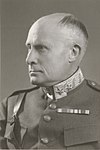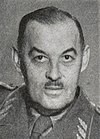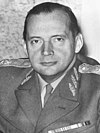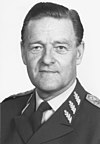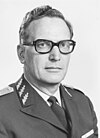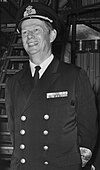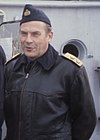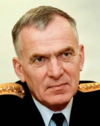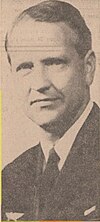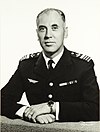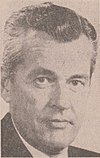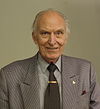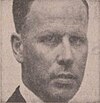Chief of the Defence Staff (Sweden)
 From Wikipedia - Reading time: 12 min
From Wikipedia - Reading time: 12 min
| Chief of the Defence Staff | |
|---|---|
| Chefen för försvarsstaben | |
 | |
since 1 October 2024 | |
| Ministry of Defence | |
| Type | Chief of the Defence Staff |
| Abbreviation | C FST |
| Reports to | Chief of Defence |
| Seat | Armed Forces Headquarters |
| Term length | No fixed term |
| Precursor | Chief of the General Staff (1st incarnation) Chief of Defence Staff (2nd incarnation) |
| Formation | 1 July 1937 (1st incarnation) 1 January 2023 (2nd incarnation) |
| First holder | MajGen Olof Thörnell |
| Final holder | VAdm Peter Nordbeck (1st incarnation) VAdm Jonas Haggren (2nd incarnation) |
| Abolished | 1993 |
| Unofficial names | Försvarsstabschef |
| Deputy | Deputy Chief of the Defence Staff |
The Chief of the Defence Staff (Swedish: Chefen för försvarsstaben, C FST, or Försvarsstabschef) is the second most senior uniformed member of the Swedish Armed Forces (after the Chief of Defence) and heads the Defence Staff. The Chief of the Defence Staff reports to the Chief of Defence and serves as their chief of staff.[1]
History
[edit]The position was created in 1937 as a successor to the Chief of the General Staff which was abolished the same year. The position was held by a senior member of one of the three main branches of the Swedish Armed Forces until 1993 when the position was abolished when the Defence Staff was disbanded. Between 2007 and 2022, the Ledningsstaben (LEDS) in the Swedish Armed Forces Headquarters was called the Defence Staff in English and was commanded by the Chief of Defence Staff (Chefen för ledningsstaben, C LEDS). The Chief of the Defence Staff position was re-established on 1 January 2023 after the Defence Staff (Ledningsstaben, LEDS) was abolished.
Tasks
[edit]The Chief of the Defence Staff serves as the Chief of Defence's chief of staff. In this role, the Chief of the Defence Staff, under the Chief of Defence, is responsible for coordinating strategic planning and military strategic command, and for ensuring that all matters, inquiries, and tasks submitted to the authority are processed and prepared as their nature requires. This responsibility includes coordinating activities within the Swedish Armed Forces Headquarters, as well as ensuring that decisions made by the authority's leadership are implemented, monitored, and that results are reported back to the leadership.[2]
Chiefs of the Defence Staff
[edit]| No. | Portrait | Chief of the Defence Staff | Took office | Left office | Time in office | Defence branch | Chief of Defence[a] | Ref. |
|---|---|---|---|---|---|---|---|---|
| 1937–1993 | ||||||||
| 1 | Lieutenant general Olof Thörnell (1877–1977) | 1 July 1937[b] | December 1939[c] | 1–2 years |  Army | – | [3] | |
| 2 | Major general Axel Bredberg (1884–1960) | 1 July 1942 | 15 November 1945[d] | 1 year, 204 days |  Army | Olof Thörnell Helge Jung | [9][7][8] | |
| - | Major general Carl August Ehrensvärd (1892–1974) Acting | 22 January 1944 | 15 November 1945 | 1 year, 297 days |  Army | Olof Thörnell Helge Jung | [7][8] | |
| 3 | Major general Carl August Ehrensvärd (1892–1974) | 15 November 1945 | 30 April 1947 | 3 years, 98 days |  Army | Helge Jung | [9][8] | |
| 4 | Major general Nils Swedlund (1898–1965) | 1 April 1947[e] | 1 April 1951 | 4 years, 0 days |  Army | Helge Jung | [10] | |
| 5 | Major general Richard Åkerman (1898–1981) | 1 April 1951 | 30 September 1957 | 6 years, 182 days |  Army | Nils Swedlund | [11] | |
| - | Major general Curt Göransson (1909–1996) Acting | 1 April 1957 | 30 September 1957 | 182 days |  Army | Nils Swedlund | [12][13] | |
| 6 | Major general Curt Göransson (1909–1996) | 1 October 1957 | 30 September 1961 | 3 years, 364 days |  Army | Nils Swedlund | [13] | |
| 7 | Major general Carl Eric Almgren (1913–2001) | 1 October 1961 | 30 March 1967 | 5 years, 180 days |  Army | Torsten Rapp | [12][14] | |
| 8 | Lieutenant general Stig Synnergren (1915–2004) | 1 April 1967 | 30 September 1970 | 3 years, 182 days |  Army | Torsten Rapp | [14][15] | |
| 9 | Lieutenant general Bo Westin (1913–2009) | 1 October 1970 | 30 September 1972 | 1 year, 365 days |  Navy (Coastal Artillery) | Stig Synnergren | [15][16] | |
| 10 | Lieutenant general Gunnar Eklund (1920–2010) | 1 October 1972 | 30 September 1976 | 3 years, 365 days |  Navy (Coastal Artillery) | Stig Synnergren | [16][17] | |
| 10 | Lieutenant general Lennart Ljung (1921–1990) | 1 October 1976 | 30 September 1978 | 1 year, 364 days |  Army | Stig Synnergren | [17][18] | |
| 11 | Vice admiral Bengt Schuback (1928–2015) | 1 October 1978 | 30 September 1982 | 3 years, 364 days |  Navy | Ola Ullsten Lennart Ljung | [18][19] | |
| 12 | Vice admiral Bror Stefenson (1929–2018) | 1 October 1982 | 31 March 1987 | 4 years, 181 days |  Navy | Lennart Ljung Bengt Gustafsson | [19][20] | |
| 13 | Lieutenant general Torsten Engberg (1934–2018) | 1 April 1987 | 30 June 1991 | 4 years, 90 days |  Navy (Coastal Artillery) | Bengt Gustafsson | [20][21] | |
| 14 | Lieutenant general Owe Wiktorin (born 1940) | 1 July 1991 | 30 September 1992 | 0–1 years |  Air Force | Bengt Gustafsson | [21][22] | |
| 15 | Vice admiral Peter Nordbeck (born 1938) | 1 October 1992 | 1993 | 0–1 years |  Navy | Bengt Gustafsson | [22] | |
| 2023–present | ||||||||
| 1 | Lieutenant general Michael Claesson (born 1965) | 1 January 2023 | 30 September 2024 | 1 year, 273 days |  Army | Micael Bydén | [23] | |
| 2 | Lieutenant general Carl-Johan Edström (born 1967) | 1 October 2024 | Incumbent | 56 days |  Air Force | Michael Claesson | [24] | |
Vice Chiefs of the Defence Staff
[edit]| No. | Portrait | Vice/Deputy Chief of the Defence Staff | Title | Took office | Left office | Time in office | Defence branch | Chief of Defence[a] | Ref. |
|---|---|---|---|---|---|---|---|---|---|
| 1 | Major general Axel Rappe (1884–1945) | Deputy Chief (Ställföreträdande chef) | 15 December 1939 | 31 March 1941 | 1 year, 106 days |  Army | Olof Thörnell | [f] | |
| 2 | Colonel Samuel Åkerhielm (1887–1976) | Deputy Chief | 3 March 1941 | 1941 | 0 years |  Army | Olof Thörnell | [g] | |
| 3 | Colonel Carl August Ehrensvärd (1892–1974) | Vice Chief (Souschef) | 1942 | 1944 | 1–2 years |  Army | Olof Thörnell | [27] | |
| 4 | Colonel Nils Swedlund (1898–1965) | Vice Chief | 1 January 1944 | 31 March 1946 | 2 years, 89 days |  Army | Helge Jung | [10] | |
| 5 | Colonel Thord Bonde (1900–1969) | Vice Chief | 1946 | 1950 | 3–4 years |  Army | Helge Jung | [h] | |
| 6 | Captain Moje Östberg (1897–1984) | Vice Chief | 1950 | 1951 | 0–1 years |  Navy | Helge Jung | [31] | |
| 7 | Colonel Sam Myhrman (1912–1965) | Vice Chief | 1956 | 1960 | 3–4 years |  Army | Nils Swedlund | [32] | |
| 8 | Colonel Åke Mangård (1917–1998) | Vice Chief | 1960 | 1961 | 0–1 years |  Air Force | Nils Swedlund | [33] | |
| 9 | Captain Dag Arvas (1913–2004) | Vice Chief | 1961 | 1964 | 2–3 years |  Navy | Torsten Rapp | [34] | |
| 10 | Captain Bengt Lundvall (1915–2010) | Vice Chief | 1964 | 1966 | 1–2 years |  Navy | Torsten Rapp | [35] | |
| 11 | Major general Bo Westin (1913–2009) | Vice Chief | 1966 | 1968 | 1–2 years |  Navy (Coastal Artillery) | Torsten Rapp | [36] | |
| 12 | Major general Dick Stenberg (1921–2004) | Vice Chief | 1 October 1968 | 1 April 1970 | 1 year, 182 days |  Air Force | Torsten Rapp | [37] | |
| 13 | Major general[i] Nils-Fredrik Palmstierna (1919–1990) | Vice Chief | 1 April 1970 | 1973 | 2–3 years |  Air Force | Stig Synnergren | [38][15] | |
| 14 | Major general Sven-Olof Olson (1926–2021) | Vice Chief | 1973 | 1977 | 3–4 years |  Air Force | Stig Synnergren | [39] | |
| 15 | Rear admiral Bengt Schuback (1928–2015) | Vice Chief | 1 July 1977 | 30 September 1978 | 1 year, 91 days |  Navy | Stig Synnergren | [40][18] | |
| 16 | Major general Bengt Lehander (1925–1994) | Vice Chief | 1 October 1978 | 30 September 1982 | 3 years, 364 days |  Air Force | Lennart Ljung | [40][19] | |
| 17 | Major general Lars-Bertil Persson (born 1934) | Deputy Chief[41] | 1 October 1982 | 1986 | 3–4 years |  Air Force | Lennart Ljung | [19][41] | |
| 18 | Major general Owe Wiktorin (born 1940) | Deputy Chief[42] | 1986 | 30 June 1991 | 4–5 years |  Air Force | Bengt Gustafsson | [42][21] | |
| 2023–present | |||||||||
| 1 | Rear admiral Jens Nykvist (born 1968) | Deputy Chief | 1 July 2023 | Incumbent | 1 year, 178 days |  Navy | Micael Bydén Michael Claesson | [43] | |
See also
[edit]- Chief of the General Staff (1873–1937)
- Chief of Defence Staff (2007–2022)
Footnotes
[edit]- ^ a b Supreme Commander 1937–2024, Chief of Defence 2024–present.
- ^ On 1 July 1936, the then Inspector General of the Infantry, Major General Olof Thörnell, was promoted to lieutenant general and at the same time appointed Chief of the Defence Staff. Thörnell now began the organization work. On 1 July 1937, the new staff gathered and the Chief of Defence Staff took command.[3]
- ^ On 8 December 1939, Thörnell was appointed Supreme Commander of the Swedish Armed Forces[4] without at the same time appointing a new Chief of the Defence Staff.[5] After Thörnell's appointment as Supreme Commander for the mobilized elements of the armed forces in December 1939, Major General Axel Rappe was appointed Deputy Chief of the Defence Staff. This meant that Rappe in reality served as Chief of the Defence Staff.[6]
- ^ Bredberg was granted a leave of absence on 21 January 1944.[7] He did not return to the post but officially left the post on 15 November 1945 when he was appointed military commander of the V Military District.[8]
- ^ Appointed on 25 February.[10]
- ^ During the winter of 1939, when Axel Rappe was commanding officer of the Svea Artillery Regiment in Stockholm, he was made available for service to the Chief of the Defence Staff. After Olof Thörnell's appointment as Supreme Commander for the mobilized elements of the armed forces in December 1939, Rappe was appointed Deputy Chief of the Defence Staff. This meant that Rappe in reality served as Chief of the Defence Staff.[6]
- ^ Furtenbach (1964) states that Åkerhielm relieved Rappe of command on 3 March 1941[25] while Cronenberg (1995-1997) states that Rappe served until 31 March 1941.[6] Harnesk (1948) states that Åkerhielm served as Deputy Chief of the Defence Staff no longer than 1941.[26] Furthermore, Furtenbach (1964) states that Åkerhielm was major general while Harnesk (1948) states that Åkerhielm was promoted to major general in 1942, a year after serving as Deputy Chief of the Defence Staff.
- ^ According to Lagerström (1968)[28] and other sources,[29] Bonde was appointed Vice Chief of the Defence Staff in 1946 and his next appointment was as second-in-command of the Svea Life Guards (I 1) in 1950. However, between these postings, Bonde held the position as Chief of Staff of United Nations Truce Supervision Organization (UNTSO) from May 1948 to July 1948.[30]
- ^ Palmstierna was colonel when taking office on 1 April and was promoted to major general on 1 October the same year.[15]
References
[edit]Notes
[edit]- ^ Interna bestämmelser 2023, pp. 5, 14
- ^ Interna bestämmelser 2023, p. 14
- ^ a b Furtenbach 1964, pp. 9, 11
- ^ "Överbefälhavare i historien" (in Swedish). Swedish Armed Forces. Archived from the original on 4 May 2019. Retrieved 2014-10-24.
- ^ Jarmar 2005, p. 71
- ^ a b c Cronenberg 1995–1997, p. 694
- ^ a b c "Tre nya generaler utnämnda". Aftonbladet (in Swedish). 21 January 1944. p. 8. Retrieved 6 May 2020.
- ^ a b c d "Chefen för försvarsstaben". Söderhamns Tidning (in Swedish). 17 November 1945. p. 8. Retrieved 6 May 2020.
- ^ a b Furtenbach 1964, p. 27
- ^ a b c Zetterberg 2014, p. 542
- ^ Furtenbach 1964, p. 42
- ^ a b Furtenbach 1964, p. 44
- ^ a b Furtenbach 1964, p. 49
- ^ a b Skoglund 2009, p. 123
- ^ a b c d GHT 1970, p. 5.
- ^ a b SvD 1972, p. 1.
- ^ a b GP 1975, p. 26.
- ^ a b c DN 1978, p. 1.
- ^ a b c d DN 1981, p. 8.
- ^ a b Falkkloo 1986, p. 18
- ^ a b c SvD 1991, p. 16.
- ^ a b GP 1992, p. 16.
- ^ "Ny organisation i Försvarsmaktens högkvarter samt utnämningar" (in Swedish). Government Offices of Sweden. 30 June 2022. Retrieved 29 August 2022.
- ^ "Regeringen placerar generallöjtnant Carl-Johan Edström som ny chef för försvarsstaben" [The government appoints Lieutenant General Carl-Johan Edström as the new Chief of the Defence Staff] (Press release) (in Swedish). Ministry of Defence. 19 September 2024. Retrieved 27 September 2024.
- ^ Furtenbach 1964, p. 33
- ^ Harnesk 1948, p. 614
- ^ "Tre nya generalmajorer, ny chef för försvarsstaben". Svenska Dagbladet (in Swedish). No. 20. 22 January 1944. p. A7. Retrieved 5 May 2020.
- ^ Lagerström 1968, p. 124
- ^ "Thord Bonde 50 år". Svenska Dagbladet (in Swedish). 16 March 1950. p. 12A. Retrieved 5 May 2020.
- ^ UNTSO News Magazine 2008, p. 23
- ^ "Nye marinattachén i Washington". Dagens Nyheter (in Swedish). 29 April 1951. p. 10A. Retrieved 5 May 2020.
- ^ Burling 1962, p. 759
- ^ Vem är det 1984, p. 758.
- ^ Uddling & Paabo 1992, p. 69
- ^ Vem är det 1984, p. 730.
- ^ Vem är det 1984, p. 1174.
- ^ Scheiderbauer 2007–2011, p. 225
- ^ Vem är det 1984, p. 877.
- ^ Vem är det 1984, p. 861.
- ^ a b Wennerholm 2015, p. 152
- ^ a b Spiegelberg 1984, p. 104
- ^ a b Bollman 1994, p. 7
- ^ Försvarets forum 2023, p. 6.
- Bollman, Ellinor (1994). "Owe Wiktorin - vår nye ÖB" [Owe Wiktorin - our new Supreme Commander] (PDF). Flygvapennytt (in Swedish) (3). Stockholm: Flygstaben. SELIBR 8257600.
- Burling, Ingeborg, ed. (1962). Vem är det: svensk biografisk handbok. 1963 [Who is it: Swedish biographical handbook. 1963] (in Swedish). Stockholm: Norstedt. SELIBR 9649168.
- Cronenberg, Arvid (1995–1997). "Axel O Rappe". Svenskt biografiskt lexikon (in Swedish). Vol. 29. National Archives of Sweden. Retrieved 11 April 2017.
- Davidsson, Åke, ed. (1966). Vem är vem?. 4, Skåne, Halland, Blekinge [Who is Who?. 4, Scania, Halland, Blekinge] (in Swedish) (2nd ed.). Stockholm: Vem är vem. SELIBR 53512.
- Furtenbach, Börje, ed. (1964). Aktuellt och Historiskt: Meddelanden från lmilitärhistoriska avdelningen vid kungl. militärhögskolan 1964 (PDF). Militärhistorisk tidskrift, 0283-8400 0283-8400 (in Swedish). Stockholm: Militärhistoriska avdelningen, Försvarsmakten. SELIBR s2pfv09xq2nfkc10.
- Harnesk, Paul, ed. (1948). Vem är vem?. D. 4, Skånedelen [Who's Who?. D. 4, Scania part] (in Swedish). Stockholm: Vem är vem bokförlag. SELIBR 8198272.
- Jarmar, Håkan (2005). Wedin, Lars; Åselius, Gunnar (eds.). "Torsten Rapp som ÖB: En studie av maktens fördelning inom det militära försvaret under 1960-talet". Militärhistorisk tidskrift. 2005 (in Swedish). Stockholm: Militärhistoriska avdelningen, Försvarshögskolan. ISSN 0283-8400. SELIBR 10098614.
- Lagerström, Sten, ed. (1968). Vem är det: svensk biografisk handbok. 1969 [Who is it: Swedish biographical handbook. 1969] (in Swedish). Stockholm: Norstedt. SELIBR 3681519.
- Scheiderbauer, Sven (2007–2011). "Dick Stenberg". Svenskt biografiskt lexikon (in Swedish). Vol. 33. National Archives of Sweden. Retrieved 11 April 2017.
- Skoglund, Claës (2009). Det bästa försvarsbeslut som aldrig kom till stånd: ett kontrafaktiskt uppslag (PDF). Publikation / Försvaret och det kalla kriget (FOKK), 1652-5388 ; 17 (in Swedish). Stockholm: Svenskt militärhistoriskt bibliotek. ISBN 9789185789573. SELIBR 11704940. Archived from the original (PDF) on 4 August 2018.
- Spiegelberg, Christina, ed. (1984). Sveriges statskalender. 1984 (in Swedish). Stockholm: Liber. ISBN 91-38-90400-4. SELIBR 3682782.
- Uddling, Hans; Paabo, Katrin, eds. (1992). Vem är det: svensk biografisk handbok. 1993 [Who is it: Swedish biographical handbook. 1993] (in Swedish). Stockholm: Norstedt. ISBN 91-1-914072-X. SELIBR 8261513.
- Wennerholm, Bertil, ed. (2015). Så kom JAS-projektet till: vittnesseminarium kring beslutsprocessen om JAS 39 1979-1983 : 11 november 2013. Forskningsprojektet Försvaret och det kalla kriget (FOKK), 1652-5388 ; 45 (in Swedish). Stockholm: Forskningsprojektet Försvaret och det kalla kriget (FoKK. ISBN 9789198049886. SELIBR 18205009.
- Zetterberg, Kent (2014). "Nils Per Robert Swedlund". Svenskt biografiskt lexikon (in Swedish). Vol. 34. National Archives of Sweden. p. 542. Retrieved 2017-12-15.
- Vem är det: svensk biografisk handbok. 1985 [Who is it: Swedish biographical handbook. 1985] (in Swedish). Stockholm: Norstedt. 1984. ISBN 91-1-843222-0. SELIBR 3681527.
- "UNITED NATIONS TRUCE SUPERVISION ORGANISATION 60th ANNIVERSARY" (PDF). UNTSO News Magazine. United Nations. 2008. Retrieved 11 April 2017.
- Försvarets traditioner i framtiden med översiktlig historik från 1500-talet (PDF) (in Swedish). Statens försvarshistoriska museer TradN. 2015. ISBN 9789197859554. SELIBR 17552963. Archived from the original (PDF) on 12 April 2017. Retrieved 11 April 2017.
- "Synnergren ny ÖB Lundvall marinchef". Göteborgs Handels- och Sjöfartstidning (in Swedish). TT. 10 January 1970. Retrieved 23 April 2020.
- "Nya stabschefer". Svenska Dagbladet (in Swedish). 4 March 1972. Retrieved 24 April 2020.
- Persson, Roland (5 December 1975). "Synnergren kvarstår Sköld ny arméchef". Göteborgs-Posten (in Swedish). Stockholm. TT. Retrieved 24 April 2020.
- Holmberg, Mats (10 February 1978). "Nye försvarsstabschefen: Kvinnor för dyra". Dagens Nyheter (in Swedish). No. 39. Retrieved 24 April 2020.
- "Ledningen möbleras om". Dagens Nyheter (in Swedish). No. 312. 17 November 1981. Retrieved 24 April 2020.
- Falkkloo, Bengt (19 December 1986). "Ny chef på staben". Dagens Nyheter (in Swedish). No. 344. Retrieved 24 April 2020.
- "Owe Wiktorin". Svenska Dagbladet (in Swedish). 28 June 1991. Retrieved 24 April 2020.
- "Ny chef för Fst". Göteborgs-Posten (in Swedish). 30 April 1992. Retrieved 24 April 2020.
- "PÅ NY POST" (PDF). Försvarets forum: Personaltidning för fast anställda och reservofficerare i svenska försvarsmakten (in Swedish) (4). Stockholm: Försvarets forum. 2023. SELIBR 4109339.
Web
[edit]- "Försvarsmaktens interna bestämmelser om ändring av Försvarsmaktens interna bestämmelser (FIB 2022:6) med arbetsordning för Försvarsmakten" (PDF) (in Swedish). Stockholm: Swedish Armed Forces. 20 December 2023. Retrieved 12 November 2024.
 KSF
KSF
